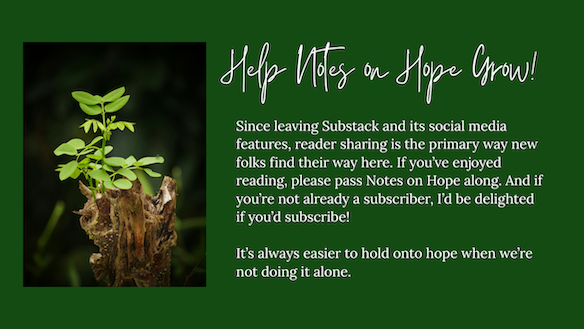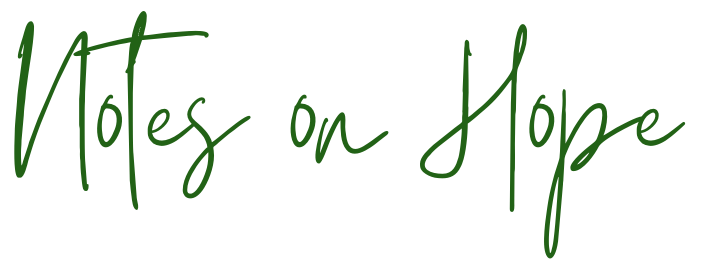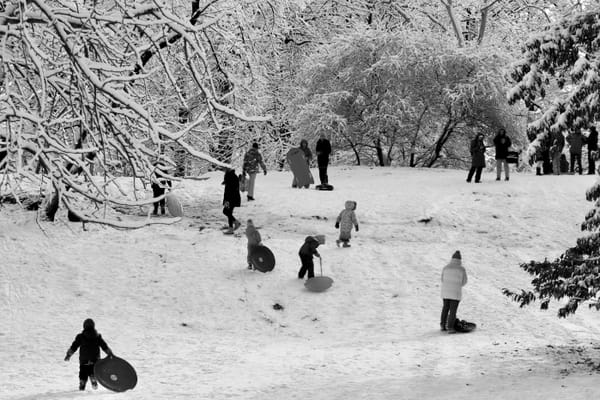Involving Kids in Community Care
Resisting the instinct to hold vulnerability at a distance

A Daily Practice
After I write Temporary on each sticky note
and press them onto socks, silverware, bills,
my hair, I put one on each maple tree in the yard
and notice I don’t think of them as eternal
as much. All it takes is a single written word
on red, yellow, green tags to remind me
the car isn’t mine. The house isn’t mine. Snow,
money, flowers do that just by being themselves
but I stick one on fear and another on hate,
pushing with all my weight so they stay. Dogs
are born with the knowledge, so no need. But
old people, even shrinking in hospice beds, yes.
Somehow they transform Temporary into Still Here.
Babies are so hard, I almost can’t. When the pad
is empty, I wait for the glue to lose its grip and fight
the urge to blow or peel them off. Sometimes a wind
comes. And I stumble around, trying to catch them.
~Michael Mark
Early in my time as a teacher, I remember finding myself perplexed by some of the most common practices for supporting children’s developing empathy and sense of community responsibility. In particular, I was struck by the fact that so many school projects that were framed as community service or community care seemed to involve little to no connection between children and any actual community. Whether they were collecting coins or canned goods or winter coats, the items would invariably pile up at school, and then they would be packed up and sent away to some anonymous organization—someone else, somewhere else.
In general, children are not great at understanding abstractions, but in the case of so many bake sales and school drives, abstraction often seemed to be somewhat central to the approach, no matter how well intentioned. The message always seemed to be that some amorphous group of other people, who were most definitely not us and not here, needed help. The coins or the cans or the mittens would be collected with dedication and then whisked off to that alternate land of need.
This doesn’t diminish the utilitarian value of meeting real needs, and engaging children in care somehow is surely better than leaving them out. But the consistent abstraction does also seem to reveal something about how we adults view children’s capacity for care and about a conflict that adults often seem to feel between wanting to both engage children in the world and protect them from really seeing the world as it is.
No matter how good the intention, this tendency to abstract the need being met often seems to end up communicating an us/them framework to children, in which the need at hand is always perceived at a distance.
I think that establishing this distance likely stems from our own fears—both from a belief that our children will become fearful if they sense any vulnerability in their own material security, and a fear of having to bear witness to that anxiety ourselves. It is understandable that, as we consider the suffering of others, we would make every effort to separate the child sitting in front of us from that suffering. A primary function of any relationship between an adult and a child is to create a sense of safety. No matter what our individual circumstances are, the instinct to minimize our children’s fears and to assure them of their own security is deep and vital. After all, our first job as caregivers is to meet children’s basic needs and to provide them with comfort and security.
But this instinct—though a crucial anchor point in our caregiving role—can also lead us to create narratives for children that may have unintended consequences, particularly when the lessons we are trying to convey brush up against some of the sharper edges of the world we know they will have to live in with increasing independence as they grow.
When it comes to engaging children in the work of caring for a world in which so many people’s basic needs aren’t met, it can, perhaps, feel necessary to relegate those in need to a fictionalized separate realm of experience and to make these categories artificially static. We say, “we have enough food, but other people…,” “we have warm coats, but other people…,” “we have a home, but other people…” As adults, we position the need always in the realm of the other and rarely as part of the “we,” separating the children in our own care from those in need by creating categories that feel distinct and impenetrable but are also inherently artificial.
Of course we do this. Of course we want to protect our children from ever needing to question whether they, personally, will have enough food or a warm place to sleep each night. Of course we want to lift them out of any individual risk, real or imagined. In the world we should all be striving to create, that sense of assurance would not only feel real but would actually be real for every single child.

And yet I’m wary of these narrative framings for several reasons. First, I worry about what these messages convey to the child in the room who does not have enough food or isn’t safe or for whom the security of those basic needs is tenuous. I’ve supervised student teachers in public and private schools throughout New York, and I can say with assurance that schools in every demographic area have children sitting in classrooms who are acutely aware that they are part of the “other people” in this framing instead of the “we,” whose personal stability, for any number of reasons, feels precarious. Creating conceptual buckets where those who give and those who are in need are placed in separate categories may help children who are already safe and secure to feel the assurance that this is an unshakable fact. But this also risks reinforcing for children who may not be safe and secure that they are outsiders, and in doing so we relegate the very children who most need our support, care, and validation further into the shadows.
Second, I worry that this framing plants a seed in children’s minds that will ultimately define the way they relate to need throughout their lives. What starts as an understandable desire to protect children who have what they need from fear and anxiety can, over time, become a lifelong belief in their own imperviousness. If vulnerability is something we can distance ourselves from as an experience only other people have, then it is something we can choose to engage with or not.
The mental categories we establish when we are children easily solidify into our worldview as we grow, and if that worldview is shaped by the perception that we are somehow distinct from those who need care and support, it is far too easy for the next step in our thinking to be some level of dehumanization of the perceived “other.” If we never see ourselves reflected in the vulnerability of others—if vulnerability is always abstract and distant—then compassion morphs into calculus. It can become too easy to decide that a person or a group that we don’t relate to is expendable.
The truth is, we have shaped a society in which most people are closer to desperation than it will ever be comfortable to acknowledge. And I would never argue for intentionally destabilizing children emotionally in order to convey this fact. But I do think we have to consider how we expand our language, particularly when we are framing categories of need and care, so that it is more possible for everyone to be included in the “we.”
There’s no easy answer for how we bring children into an understanding of our common vulnerability, while still meeting our adult obligations to help them feel safe and cared for. But I think that acknowledging the challenge itself is the beginning of an answer. In these fraught moments in our relationships with children, it is easy to grasp at tips and tricks—to look for prescribed language that will magically instill compassion, while also totally averting anxiety. But, in acknowledging that there is no easy answer or perfect language to resolve this tension, what we are left with is the security of our honest, caring relationships with children. And I think those honest relationships are actually far more durable and reassuring than the artificial security that it’s so tempting to create through abstractions and static categories of human need.
We may not be able to assure children of the security of possessions, but we can assure them of the security of our love and care. We can’t create a perfect world for them or map out a completely safe and certain future. But we can assure them that we will do everything possible to walk alongside them and to make sure they don’t have to feel alone in their uncertainty.
Here, also, is where a framework of mutual aid can, I think, be a more powerful starting point than charity, not only for actually ensuring people have what they need, but also for engaging children in a form of care that is collective rather than reliant on defining an imagined other. There is a powerful message of safety in knowing that, while we may all be vulnerable, we are also all part of a network of care. This message might even provide a form of reassurance that is more honest, more lasting, and more impactful than a message that places children outside of or above that network of care.
By teaching children that we can all help each other, instead of signaling that they can offer help to an abstract other, we not only avoid conveying need in categories that establish a feeling of cold separateness, but we also communicate to children that they, too, are part of a community of care and connection. We might all be more vulnerable than it is comfortable to acknowledge, but if we are also part of a larger network of care, perhaps that’s not so scary. There’s reassurance in community. When we help because we are part of a caring collective, we diminish the shame of being in need, and we, in turn, are more able to see the support that would be there for us if we were in need.
Surely there is always some inherent anxiety in reckoning with the fragility of our material resources. And, of course, it would be better if we could choose to create systems that ensure everyone’s basic needs were met. But there is also tremendous comfort in seeing people rise up to help each other and in knowing that we are a part of that fabric, not separate from it.
As a simple example, I think the most meaningful community project I’ve ever seen take shape in a classroom involved a relatively small gesture—filling a community fridge just a few blocks from our school. In many ways, this was a much more modest project than the canned food collections or the year-long coin drives that are so common in schools. But filling a fridge in their own community involved acknowledging vulnerability that was extremely proximal, which is often the opposite of the instinct we have as adults engaging in these conversations and projects with children. It’s tempting to place need at a distance, to make it somehow “real but not here” for children or “real but not us.” But in doing this, we also rob children of being able to see that care is not only for others but is for everyone who needs it—including them. They may not need the fridge around the corner today. But if they do, they don't have to hide it. Today they might be in a position to help fill it up. But engaging with such a practical solution so close to home also means that the same resource could be there for them.
What if we didn’t need to be so afraid of acknowledging our collective vulnerability to our children? What if there could be even more security in knowing that none of us is impervious, because inherent in this knowledge is an awareness that we are all deserving of care and that we are all part of the fabric of giving and receiving care. Naming our mutual precariousness can be scary for adults and children alike. But if doing so opens the door to naming our mutual support and protection of one another, I think perhaps there is actually more safety in that understanding than in the isolation of a framework that draws artificial lines between those who give and those who receive.
Maybe we would all feel safer if we were more willing to see ourselves, simultaneously, in the eyes of the most vulnerable person and in the hand extended toward them.
Wishing you the security of a network of mutual vulnerability and mutual care,
Alicia
P.S. An update on last week’s note. You may have read that two federal judges ordered contingency funds be used to continue distributing SNAP, as is required by law. This is potentially good news. However, it is still unclear when, how, or even if these orders will be executed. Even before SNAP was on the line, food banks were already seeing rising need. And, as of Nov 1st, 42 million people were cut off from access to food, including 16 million children. If you need help or if you are able to give help, the resources in last week’s note remain relevant. FindHelp.org is also an invaluable tool for locating food assistance, as well as many other essential resources. I've also included a few more links to resources below.
A few things I found helpful and hopeful this week…
- FindHelp - A tool for locating local assistance across all areas of need from food to housing to medical care to legal support
- Feed Thy Neighbor - An extensive list of food resources from Erin Boyle
- We Feed Each Other: Because who are we if we don't? - As usual Garrett Bucks offers a reminder of what community care can look like in real day-to-day life
- This week's episode of Vibe Check offers a really valuable and informative conversation about the current SNAP crisis
- How Sudanese Women Are Building Lifelines
- When ICE Sweeps Up Parents, NYC Schools Step Up Their Support






